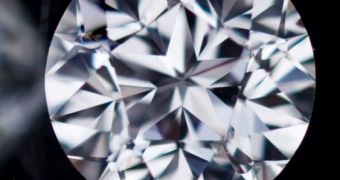Sarah Tolbert, from the University of California at Los Angeles, US, together with Richard Kaner and other colleagues have developed a super-hard material that is tough enough to scratch diamond.
Until now, diamond has been the hardest natural material known to humans and the third hardest known material after the artificially engineered aggregated diamond nanorods and ultrahard fullerite.
Ultrahard fullerite (C60) is a form of carbon which has been found to be harder than diamond, and which can be used to create even harder materials, such as aggregated diamond nanorods. These are allotropes of carbon believed to be the hardest and least compressible known material.
The newly created material is made from the metal rhenium and the element boron and resembles both a metal and a crystal in structure. These materials are better than diamond at some tasks, such as cutting steel, since the carbon in diamond reacts with steel to form iron carbide, dulling the cutting surface.
The team created their material - rhenium diboride - without resorting to high pressures. "We wanted to change the ease with which hard materials are made," Tolbert says.
To begin with, they considered what makes substances hard. Metals are difficult to compress because their atoms carry dense coats of electrons that repel neighboring atoms, although this means they can still bend. On the other hand, the atoms in stiff crystals such as diamond have bonds in rigidly prescribed directions, which create a strong, regular scaffold that resists bending, skewing or breaking.
Tolbert and colleagues devised a way to incorporate both these properties into applications. They combined rhenium, a hard-to-compress metal, with boron, which forms strong bonds with rhenium to create a highly incompressible material that also has a rigid scaffold of bonds on the inside.
The material is nearly as hard as cubic boron nitride and boron suboxide, two of the hardest materials known, and like them can scratch diamond. It should also be able to cut steel without reacting chemically with the iron.
"But all the known super-hard materials are very expensive because they [have to be] made at high pressure," says Sarah Tolbert. Their new discovery could be made cheaply and easily, and is considered to be just the tip of the iceberg for this family of materials.

 14 DAY TRIAL //
14 DAY TRIAL //